Iliocostalis Cervicis: Difference between revisions
mNo edit summary |
No edit summary |
||
| Line 3: | Line 3: | ||
'''Top Contributors''' - {{Special:Contributors/{{FULLPAGENAME}}}} | '''Top Contributors''' - {{Special:Contributors/{{FULLPAGENAME}}}} | ||
</div> | </div> | ||
[[File:Sagittal section of the cervical spine Primal.png|right|frameless|400x400px]] | |||
== Description == | == Description == | ||
Iliocostalis Cervicis is also known as cervicalis ascendens. It is the cervical portion of the iliocostal muscle.<ref name=":0">Roldan CJ, Huh BK. [https://www.painphysicianjournal.com/current/pdf?article=MjkwNg%3D%3D&journal=98 Iliocostalis thoracis-lumborum myofascial pain]: Reviewing a subgroup of a prospective, randomized, blinded trial. A challenging diagnosis with clinical implications. Pain physician. 2016 Aug 1;19(6):363-72.</ref>It consists of long and slender tendons. | Iliocostalis Cervicis is also known as cervicalis ascendens. It is the cervical portion of the iliocostal [[muscle]].<ref name=":0">Roldan CJ, Huh BK. [https://www.painphysicianjournal.com/current/pdf?article=MjkwNg%3D%3D&journal=98 Iliocostalis thoracis-lumborum myofascial pain]: Reviewing a subgroup of a prospective, randomized, blinded trial. A challenging diagnosis with clinical implications. Pain physician. 2016 Aug 1;19(6):363-72.</ref>It consists of long and slender tendons. | ||
=== Origin === | === Origin === | ||
The muscle arises from the superior aspect of the angle of the third through sixth ribs.<ref name=":1">Cramer GD, Darby SA. Clinical anatomy of the spine, spinal cord, and ANS-e-book.</ref> | The muscle arises from the superior aspect of the angle of the third through sixth [[ribs]].<ref name=":1">Cramer GD, Darby SA. Clinical anatomy of the spine, spinal cord, and ANS-e-book.</ref> | ||
=== Insertion === | === Insertion === | ||
It is inserted superiorly onto the posterior tubercles of the transverse processes of the C4 to C6 vertebra.<ref name=":1" /> | It is inserted superiorly onto the posterior tubercles of the transverse processes of the C4 to C6 [[Cervical Vertebrae|vertebra]].<ref name=":1" /> | ||
=== Nerve === | === Nerve === | ||
| Line 17: | Line 19: | ||
=== Artery === | === Artery === | ||
The [[blood]] supply originates in the muscular branches of the aorta.<ref name=":0" /> | |||
== Function == | == Function == | ||
Laterally flexes and extends the lower [[Cervical Anatomy|cervical region.]]<ref name=":1" /> | |||
= | Maintains the erect [[posture]] and stabilizes the vertebral column during flexion in the upper portion of the torso. It also acts in contrast to [[Abdominal Muscles|abdominal muscles]] and in opposition to the action of gravity. When used unilaterally, it is a lateral flexor and a same-side rotator.<ref name=":0" /> | ||
== Treatment == | == Treatment == | ||
Revision as of 12:32, 28 March 2021
Original Editor - Kakshya Rupakheti
Top Contributors - Kakshya Rupakheti, Aminat Abolade and Lucinda hampton
Description[edit | edit source]
Iliocostalis Cervicis is also known as cervicalis ascendens. It is the cervical portion of the iliocostal muscle.[1]It consists of long and slender tendons.
Origin[edit | edit source]
The muscle arises from the superior aspect of the angle of the third through sixth ribs.[2]
Insertion[edit | edit source]
It is inserted superiorly onto the posterior tubercles of the transverse processes of the C4 to C6 vertebra.[2]
Nerve[edit | edit source]
It is innervated by the dorsal rami of the upper thoracic and lower cervical spinal nerves.[2]
Artery[edit | edit source]
The blood supply originates in the muscular branches of the aorta.[1]
Function[edit | edit source]
Laterally flexes and extends the lower cervical region.[2]
Maintains the erect posture and stabilizes the vertebral column during flexion in the upper portion of the torso. It also acts in contrast to abdominal muscles and in opposition to the action of gravity. When used unilaterally, it is a lateral flexor and a same-side rotator.[1]
Treatment[edit | edit source]
No specific
See also Iliocostalis Lumborum
Resources[edit | edit source]
- ↑ 1.0 1.1 1.2 Roldan CJ, Huh BK. Iliocostalis thoracis-lumborum myofascial pain: Reviewing a subgroup of a prospective, randomized, blinded trial. A challenging diagnosis with clinical implications. Pain physician. 2016 Aug 1;19(6):363-72.
- ↑ 2.0 2.1 2.2 2.3 Cramer GD, Darby SA. Clinical anatomy of the spine, spinal cord, and ANS-e-book.







